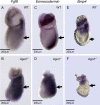Argonaute2 is essential for mammalian gastrulation and proper mesoderm formation
- PMID: 18166081
- PMCID: PMC2323323
- DOI: 10.1371/journal.pgen.0030227
Argonaute2 is essential for mammalian gastrulation and proper mesoderm formation
Abstract
Mammalian Argonaute proteins (EIF2C1-4) play an essential role in RNA-induced silencing. Here, we show that the loss of eIF2C2 (Argonaute2 or Ago2) results in gastrulation arrest, ectopic expression of Brachyury (T), and mesoderm expansion. We identify a genetic interaction between Ago2 and T, as Ago2 haploinsufficiency partially rescues the classic T/+ short-tail phenotype. Finally, we demonstrate that the ectopic T expression and concomitant mesoderm expansion result from disrupted fibroblast growth factor signaling, likely due to aberrant expression of Eomesodermin. Together, these data indicate that a factor best known as a key component of the RNA-induced silencing complex is required for proper fibroblast growth factor signaling during gastrulation, suggesting a possible micro-RNA function in the formation of a mammalian germ layer.
Conflict of interest statement
Competing interests. The authors have declared that no competing interests exist.
Figures





References
-
- Song JJ, Smith SK, Hannon GJ, Joshua-Tor L. Crystal structure of Argonaute and its implications for RISC slicer activity. Science. 2004;305:1434–1437. - PubMed
-
- Lingel A, Simon B, Izaurralde E, Sattler M. Structure and nucleic-acid binding of the Drosophila Argonaute 2 PAZ domain. Nature. 2003;426:465–469. - PubMed
-
- Yan KS, Yan S, Farooq A, Han A, Zeng L, et al. Structure and conserved RNA binding of the PAZ domain [erratum appears in Nature. 2004 Jan 15;427(6971):265] Nature. 2003;426:468–474. - PubMed
-
- Song JJ, Liu J, Tolia NH, Schneiderman J, Smith SK, et al. The crystal structure of the Argonaute2 PAZ domain reveals an RNA binding motif in RNAi effector complexes. Nat Struct Biol. 2003;10:1026–1032. - PubMed
Publication types
MeSH terms
Substances
Grants and funding
LinkOut - more resources
Full Text Sources

